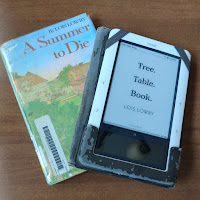Magoon, Kekla. The Secret Library
May 7, 2024 by Candlewick Press
May 7, 2024 by Candlewick Press
ARC provided by Young Adult Books Central
Dally (Delilah) Peteharrigan is grieving the death of her beloved grandfather, especially since she has already lost her father, who was Black, and her mother, who is white, is very busy managing the family's company. Her mother is determined that Dally learn a lot, so she is not only enrolled in a private school, but also has lessons in subjects like economics afterwards. Her free time is limited to one hour, so even after Dally makes an impressive plea to join the school Adventure Club, she is not allowed. After this, Dally is determined to get the envelope that her grandfather left her, and breaks into his office. There's a puzzle and a map involved, and Dally pins to location to a bakery too far from her home to walk. She enlists the aid of a car service the family often uses, and when she arrives at the location, a magical library appears. She is greeted by the librarian, Jennacake, who tells her that the library houses secrets, and that Dally is allowed to see one a day. There are a wide variety of secrets, and Dally sees some about how her parents met, and small lies that people tell. Nothing too earth shaking happens at first, and her time spent in the vesions of the past is short, but she eventually ends up in a rousing adventure on the high seas, along with well-meaning pirates Pete and Eli, as well as a boy about her age, Jack. She can't really figure out what the secret is, but the more she pops into various timelines, the more she finds out about the history of her family, and the reasons why her mother is so cautious with the family finanaces. She also learns that Jack is using the library to travel into secrets as well, but he is from 1960. Her mother's controlling behavior doesn't stop, and when Dally learns that her own future might be very circumscribed, she has to think about the path she should take. The library just holds the secrets, but how those secrets effect Dally and her family can be earth shattering. (Don't want to give away too much!)
The Secret Library is right up there with Shulman's The Grimm Legacy (2021) and MacHale's The Library (The Curse of the Boggin, 2016) or Wexler's The Forbidden Library (2014) in terms of good use of magical books. I know it was important for Dally to travel into secrets, but I would have been content to spend a lot more time with Jennacake touring the facilities.
It's good that the book ended with a family tree, so that we were able to see how all of the different ancestors that Dally met figured into the story. There's a lot of different points in time shown in Dally's travels, and the chart really helped me tie together all of the different bits of information. There is also a bit of a surprise ending, so be prepared!
This is definitely on trend with a lot of current sociopolitical topics. There are several instances of Dally's father experiencing racism in college, and the history of racism as it effects Dally's family goes back into the mid 1800s. There is a very important instance of "passing" that has lasting ramifications and is not a topic I have seen much addressed in middle grade fiction. Pete and Eli have LBGTQIA+ ties in unusual ways that also form the family's history.
Readers who liked Shawl's Speculation (2022) or Coles' Black Was the Ink (2021), and prefer their history presented with some fantastic flourishes will enjoy Dally's exploration of her family's past in The Secret Library. 







.jpg)









.jpg)











































